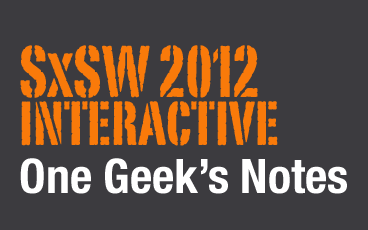
by Laura Creekmore | Mar 11, 2012 | Conferences/Events
Just made it to a few sessions this year at South by Southwest, but they were good ones. If you’d like to catch up, here are the notes I took: Big Data and the Race for the White House Jared Spool: The Secret Lives of Links danah boyd: The Power of Fear in...
by Laura Creekmore | Mar 11, 2012 | Conferences/Events
Patrick Ruffini is moderating, suggests another name for the panel could be “Moneyball for Politics.” Excellent — I’m clearly in the right place. Going to talk about all the uses for big data, how it’s used in politics for prediction,...
by Laura Creekmore | Mar 10, 2012 | Conferences/Events, User experience
OK, the few hundred people in the room here with me are the ONLY people at SXSW not hearing Frank Abagnale talk right now. Wow. The great benefit of coming to see Jared Spool talk is getting to see him dance to Beyoncé’s All the Single Ladies. I gotta call him...
by Laura Creekmore | Mar 10, 2012 | Conferences/Events, Privacy, Social media
Always interesting to hear what danah boyd is thinking and writing about. Notes below are a mixture of quotes, paraphrases and near-quotes. boyd starts off by recommending everyone attend Baratunde Thurston’s keynote at 2p. Started with three points….I...
by Laura Creekmore | Aug 16, 2011 | Conferences/Events, Content strategy, Speaking
Well, it’s that time again — time that all the web-nerds penciled in our calendars months ago: The SXSW Panel Picker is open for voting! If you’ve never been to the all-things-web-digital-music-and-film that is SXSW in Austin each March, I’m...


